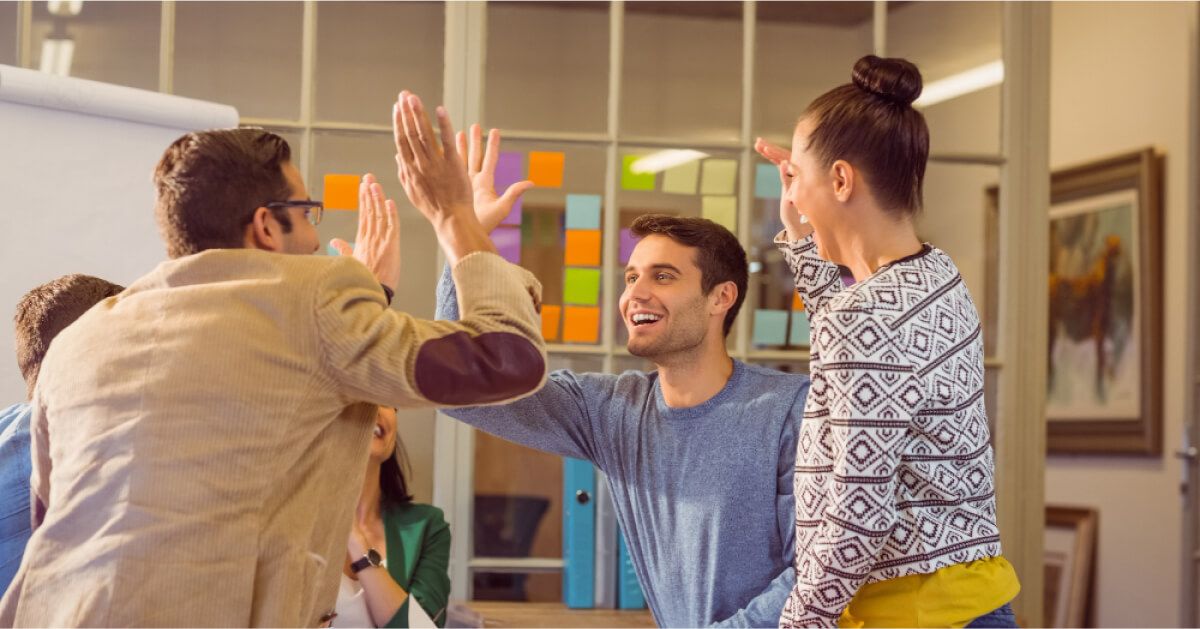Positive work environment: Everything you need to know

Remember those long summer evenings when the whole neighborhood gathered for to play something? No one cared who won. It was about laughter, shared snacks, and the joy of just showing up together.
That same effortless connection is what every great workplace hopes to recreate. It is less about big changes and more about the feeling people get when they walk in.
A positive work environment begins when people feel safe to speak, supported when they stumble, and appreciated for their efforts. When that sense of belonging grows, teamwork and motivation follow naturally.
- Builds trust, communication, and collaboration by fostering respect and psychological safety where people feel valued and supported every day.
- Improves employee satisfaction, motivation, and retention while reducing stress, burnout, and absenteeism through a supportive and inclusive culture.
- Encourages recognition, growth, and balance as core pillars that drive engagement, productivity, and long-term organizational success.
- Empowers managers to lead with empathy, openness, and fairness to maintain harmony and inspire consistent team performance.
- Sustains positivity through continuous feedback, flexibility, and well-being initiatives that nurture a resilient, high-performing workplace culture.
What is a positive working environment?

A positive work environment fosters trust, recognition, well-being, and collaboration, making employees feel valued and engaged.
It boosts satisfaction, health, and productivity while lowering stress and turnover, creating a thriving, resilient, and innovative workplace.
A positive working environment is more than just a well-lit office or free coffee—it's about creating a culture where employees feel valued, supported, and motivated. But what is a positive work environment, exactly? At its core, it’s a positive environment that fosters collaboration, trust, and well-being, ensuring people can thrive.
A strong positive work environment definition includes open communication, respect, and growth opportunities.
While no two workplaces are identical, there are good working environment examples across industries. Some prioritize flexible schedules, while others focus on team bonding, leadership support, or professional development. The key is finding what works for your people.
A good working environment doesn’t mean eliminating stress completely—but it does mean equipping employees with the tools and mindset to navigate challenges together. When done right, a good work environment becomes more than just a workplace; it transforms into a space where people want to grow, contribute, and succeed.
6 Types of work environments

The six types of work environments are:
1. Traditional office environment
This is the most common and traditional type of work environment where employees work from a central office location. It typically consists of cubicles, private offices, conference rooms, and communal areas.
In this setting, employees usually work fixed hours and interact face-to-face with their colleagues and supervisors.
2. Remote or virtual work environment
With advancements in technology, remote work has become increasingly prevalent. In this type of environment, employees have the flexibility to work from locations outside of a central, physical office space, such as their homes or co-working spaces.
Communication and collaboration are often facilitated through digital tools like video conferencing, email, and project management software.
3. Hybrid work environment
As the name suggests, a hybrid work environment is a combination of both traditional and remote work setups. Employees have the flexibility to divide their work time between the central. This model allows for greater work-life balance and often involves a mix of in-person and virtual collaboration.
It's important to note that the prevalence and types of work environments can vary across industries, organizations, and geographic locations. The choice of work environment depends on various factors, including the company's values, the nature of the work, the company's culture, and the preferences of the employees.
4. Creative work environment
A creative work environment fosters originality and innovation, making it a positive workplace environment for those who thrive on out-of-the-box thinking. Often seen in design firms, advertising agencies, and startups, this work environment encourages employees to brainstorm, take risks, and explore new ideas.
A good work environment here means flexibility, open collaboration, and an inspiring setting that fuels creativity.
5. Competitive work environment
This work environment is fast-paced and goal-driven, often found in finance, sales, and law. While demanding, it offers great work environment benefits for those who excel under pressure. Employees work towards ambitious targets, and success is celebrated with recognition and rewards.
Maintaining a positive working culture in such an environment requires motivation, resilience, and a strong support system to ensure a good working atmosphere despite high expectations.
6. Collaborative work environment
A good workplace environment thrives on teamwork, shared goals, and open communication. Found in industries like healthcare and tech, this setting prioritizes mutual support and problem-solving, aligning with the positive work environment meaning.
Employees collaborate, exchange ideas, and build trust, creating a positive workplace environment where people feel valued. When teams work together effectively, it leads to a truly great work environment.
Across those settings, culture acts like a multiplier. When habits align, benefits compound. When signals clash, risks grow quietly. Understanding the upside and downside clarifies why design choices matter and which tradeoffs to tackle first for lasting traction.
Fostering positivity at work: How to cheer up a coworker?

Fostering positivity at work is crucial for maintaining a healthy and collaborative professional environment. When a coworker is feeling down, it becomes a collective responsibility to uplift their spirits. Here are nine effective ways to cheer up a coworker and contribute to a positive workplace atmosphere:
- Express empathy: Start by expressing genuine empathy. Let your coworker know that you understand they may be going through a tough time and that you are there to offer support. A simple, "I'm here for you if you need anything," can make a significant difference.
- Offer a listening ear: Sometimes, a sympathetic listener is all someone needs. Encourage your coworker to share their thoughts and feelings. Actively listen without judgment, providing a safe space for them to express themselves.
- Provide encouragement: Offer words of encouragement and positive affirmations. Remind your coworker of their strengths, past achievements, and capabilities. Sometimes, a boost in confidence can go a long way in lifting their spirits.
- Small acts of kindness: Engage in small acts of kindness to show your support. This could include bringing them a cup of coffee, leaving a thoughtful note on their desk, or offering to help with tasks to lighten their workload.
- Organize a team celebration: Rally your team to organize a small celebration in honor of your coworker. It could be a surprise birthday celebration, a recognition event for their achievements, or simply a casual get-together to boost morale.
- Create a positive workspace: Infuse positivity into the work environment. Decorate the coworker's desk with uplifting quotes, flowers, or other cheerful items. A visually positive workspace can have a direct impact on their mood.
- Initiate group activities: Organize group activities that promote camaraderie and teamwork. This could be team-building exercises, lunch outings, or even collaborative projects. Building a sense of unity among coworkers contributes to a more positive overall atmosphere.
- Encourage a healthy work-life balance: Remind your coworker about the importance of maintaining a healthy work-life balance. Encourage them to take breaks, step outside for fresh air, and engage in activities they enjoy outside of work. A balanced life often leads to a more positive mindset.
- Provide resources for support: Share information about available resources, such as employee assistance programs or counseling services, if your coworker is going through a particularly challenging time. Ensure they are aware of the support networks within the organization.
Benefits of positive culture vs. Risks of poor culture
Workplace culture is a critical driver of organizational success or failure. The way employees experience their daily environment impacts employee wellness, motivation, collaboration, retention, and even your company’s culture and reputation.
The table below highlights key cultural aspects, showing how each one can either contribute to a thriving workplace or lead to costly setbacks when overlooked.
To tilt outcomes toward the upside, ground operations in a few core pillars. Pillars translate ideals into repeatable behaviors leaders can coach. They reduce noise, steady expectations, and provide handles for teams to practice consistently during real work.
Core pillars and key elements of a productive, positive, and happy workplace
Building a positive workplace culture is like tuning a band before a concert: small adjustments decide whether the music flows or jars. Get the basics right and every section amplifies the rest. Below are the core moves leaders use for fostering a positive work environment that stays resilient. Practical and easy to spot in routines.
- Psychological safety: Define the positive work environment meaning through voice without fear, respectful debate, and course corrections. This builds a healthy workplace environment where people surface risks early, share ideas, and learn fast so quality improves before deadlines hit.
- Clarity and purpose: Set simple goals, transparent roles, and rituals that align workplace and culture. A professional environment with unambiguous priorities reduces friction, speeds decisions, and lets teams coordinate autonomously, turning routine tasks into momentum builders rather than energy drains.
- Recognition that lands: Make appreciation specific, timely, and visible. Highlight learning, not just wins. The benefits of a positive work environment multiply when leaders use praise walls, notes, or positive work environment quotes that reinforce desired behaviors and celebrate contributors.
- Growth and autonomy: Offer stretch projects, coaching, and clear career paths. A nurturing work environment paired with decision latitude creates a good working environment where people try smarter approaches, own outcomes, and compound skills that lift the whole team.
- Balance by design: Normalize boundaries, sustainable pacing, and flexible schedules. A balanced workplace supports deep work and recovery. That rhythm protects a healthy workplace environment, reduces burnout signals early, and increases focus during crunch periods without heroic, last minute rescues.
- Communication that travels: Share context widely, invite questions, and summarize decisions in plain language. Consistent messaging builds a positive workplace culture where the work environment feels predictable, conflicts surface sooner, and cross-team handoffs happen smoothly with fewer costly reworks.
- Inclusive practices: Design hiring, feedback, and meetings so diverse voices shape workplace and culture. Use rotating facilitation, agenda previews, and structured feedback. Positive work environment examples emerge when decisions improve because more perspectives are considered early, not retrofitted later.
- Everyday rituals: Start-of-week priorities, demo days, and quick retros create rhythm. These small ceremonies anchor a professional environment, reduce ambiguity, and give people predictable touchpoints where progress is noticed and blockers get lifted before they slow momentum significantly.
When pillars take root, they show up as recognizable traits. These characteristics make positivity visible and measurable. You can see how decisions happen, how information moves, and how people respond when priorities shift or pressure rises.
Characteristics of positive working environments

Positive working environments are built on trust, respect, and a focus on employee well-being. Here are the defining good working environment characteristics:
- Transparent and open communication: Employees feel safe sharing ideas, concerns, and feedback without fear of judgment.
- Empowering leadership: Leaders inspire, support, and delegate effectively, fostering ownership and accountability.
- Recognition and appreciation: Employees’ efforts and achievements are acknowledged, creating a sense of value and belonging.
- Flexibility and work-life balance: Flexible hours, remote options, and family-friendly policies enhance well-being and loyalty.
- Opportunities for growth and development: Continuous learning and career advancement opportunities encourage long-term dedication.
- Collaborative and supportive culture: Teams value cooperation and camaraderie, focusing on collective success.
- Emphasis on well-being: Mental, emotional, and social well-being are supported through wellness programs and stress management.
- Diversity and inclusion: Individual differences are celebrated, bringing diverse perspectives and enriching the workplace and employee morale.
- Clear goals and expectations: Employees understand their roles and responsibilities, aligning with organizational objectives.
- Effective conflict resolution: Issues are addressed constructively, turning conflict into opportunities for improvement.
- Employee involvement in decision-making: Staff are encouraged to contribute ideas and participate in decisions, fostering ownership and improving company culture.
- Adaptability and innovation: Change is embraced, and employees are encouraged to propose new ideas and solutions.
- Social connections and team-building activities: Strong interpersonal bonds are built through events and informal gatherings.
- Fair compensation and benefits: Employees are fairly rewarded, which maintains morale and motivation.
- Sustainable practices: Commitment to social and environmental responsibility enhances employee pride and engagement.
Those traits are not cosmetic. They shape how people feel, focus, and recover. The environment affects energy, clarity, and follow-through. Connecting characteristics to employee impact helps teams justify investments and stay disciplined when momentum dips or deadlines tighten.
Characteristics of a positive working environment
Creating a positive work environment is like tending a well-balanced garden. Every small act, watering, pruning, sunlight, matters. When leaders and teams consistently nurture trust, communication, and care, the culture flourishes naturally. Below are the everyday traits that define positivity in the workplace and help in cultivating a positive work environment.
- Open and transparent communication: Clear, honest communication builds trust and alignment. It keeps teams focused, reduces confusion, and turns feedback into progress, forming the base for creating a productive work environment where everyone stays informed and engaged.
- Trust and accountability: A better work environment thrives when people trust one another and take ownership. When promises are kept and accountability is shared, positive staff relationships deepen, and collaboration strengthens across all types of work environments.
- Empowering leadership: Leaders who listen, guide, and support rather than control set the tone for positivity. This approach boosts improved employee satisfaction and helps in creating a positive work environment that feels safe and energizing.
- Recognition and appreciation: People repeat behaviors that are valued. A culture of appreciation celebrates small wins and effort, reinforcing positivity in the workplace and showing how to create a positive work environment as an employee or manager.
- Opportunities for growth: When employees see pathways to learn and advance, they invest deeper in their roles. Growth-oriented teams create momentum, leading to a consistently better work environment where curiosity and ambition fuel performance.
- Work-life balance: A positive work culture respects time, flexibility, and rest. Allowing breathing space helps maintain energy and focus, ensuring that teams stay productive while avoiding burnout across all types of work environments.
- Psychological safety: Teams innovate when they feel safe to question, suggest, or fail without fear. This emotional grounding cultivates a positive work environment that inspires confidence, creativity, and stronger team connection.
- Inclusivity and fairness: Equal opportunities and transparent decision-making create trust. When everyone feels heard and represented, cultivating a positive work environment becomes second nature, and collaboration turns naturally inclusive.
- Supportive systems: Access to the right tools, resources, and leadership guidance is crucial. These things to improve on at work ensure that productivity, morale, and focus stay consistent even during demanding cycles.
- Shared purpose and values: Teams united by a common mission demonstrate stronger resilience. A positive work culture grows when everyone’s daily effort connects to something bigger, making work meaningful and collective success possible.
When you recognize the traits of a positive working environment, the next question is how those traits translate into real outcomes. The ripple effect is powerful, what starts as trust and respect soon impacts motivation, mental health, and overall employees performance across the organization.
How does a positive work environment affect employees?

A positive work environment significantly influences employees in various ways, profoundly impacting their well-being, performance, and overall job satisfaction.
TL;DR
A positive work environment boosts satisfaction, motivation, and health while fostering collaboration, retention, and innovation.
Employees feel valued and engaged, reducing stress and improving performance.
Such workplaces attract talent, strengthen teams, and enhance customer service, creating a culture where employees and the organization thrive together.
- Enhanced job satisfaction: Employees thriving in a positive work environment experience heightened job satisfaction. Feeling valued, supported, and appreciated creates a sense of fulfillment, making the work experience more enjoyable.
- Increased motivation and productivity: Positive work environments cultivate motivation among employees. When individuals feel happy and supported, their productivity levels soar. The encouragement of creativity, innovation, and problem-solving leads to improved performance and results.
- Improved mental and physical health: Contrastingly, negative work environments can contribute to stress and burnout. A positive work atmosphere, however, supports employees' mental and physical well-being, reducing absenteeism and fostering a healthier workforce.
- Strengthened team collaboration: Positive work environments promote open communication, trust, and teamwork. Employees are more likely to collaborate, share ideas, and work harmoniously together. This cohesion results in a more productive and efficient team.
- Enhanced employee retention: In positive work environments, employees are more likely to stay with the company for the long term. The supportive and respectful atmosphere reduces turnover, saving the organization recruitment and training costs.
- Attraction of top talent: Positive work environments become magnets for top talent. Skilled professionals seek organizations that prioritize employee well-being and a positive work culture, making recruitment and retention efforts more successful.
- Better customer experience: Employee satisfaction directly correlates with customer satisfaction. Happy and motivated employees are more likely to provide exceptional customer service, contributing to increased customer satisfaction and loyalty.
Understanding how a positive work environment influences employees sets the stage for action. Seeing the benefits is one thing, but witnessing them in practice is another.
The next step is exploring a real-world example that shows how creating a positive workplace culture actually works day-to-day.
What is an example of creating a positive workplace culture?

There are numerous ways to build and create a positive work environment. Let’s dive into a simple example.
Let’s assume you are the newly appointed HR manager of a reputable manufacturing company, you recognize the immense value of fostering a culture of open communication and transparency. To encourage regular employee feedback and ensure their voices are heard, you propose implementing an "Open Door Policy."
- Communicate the policy: Organize a company-wide meeting to introduce the Open Door Policy to all employees. Explain that this initiative aims to create a safe and supportive space for them to share feedback, suggestions, or concerns at any time.
- Designate approachable points of contact: Appoint specific managers or HR representatives as designated points of contact for the open door policy. Make sure these individuals are known for their approachability, empathy, and discretion.
- Create anonymous feedback channels: In addition to direct communication, set up anonymous feedback channels such as suggestion boxes, digital forms, or confidential email addresses. This allows employees to share sensitive feedback without fear of repercussions e.g., for the employer to find their email address.
- Schedule regular one-on-one meetings: Encourage managers to schedule regular one-on-one meetings with their team members. This provides an opportunity for employees to discuss any concerns or ideas privately and in a more personal setting.
- Training for managers: Provide training to managers on active listening and constructive feedback techniques. This ensures that when employees do share their thoughts, they feel genuinely heard and supported.
- Acknowledge and respond: Promptly acknowledge feedback received through the Open Door Policy, whether it's positive reinforcement or constructive criticism. Respond to employees with gratitude for their input and communicate the steps being taken, if applicable.
- Foster a learning culture: Encourage a learning culture by valuing mistakes as opportunities for growth and improvement. Emphasize that providing feedback is a constructive process that benefits the entire organization.
- Implement positive changes: Whenever feasible, implement changes based on employee feedback and communicate these improvements throughout the company. Showing that feedback leads to tangible improvements reinforces the value of the Open Door Policy.
- Periodic reviews: Periodically review the effectiveness of the Open Door Policy. Analyze feedback trends, assess employee engagement, and seek suggestions on how to further enhance the feedback process.
- Recognize feedback champions: Acknowledge employees who actively participate in providing feedback and contributing to positive changes. Recognizing their efforts motivates others to engage with the Open Door Policy.
This continuous feedback loop enhances employee engagement, boosts morale, and fosters a culture of trust and openness throughout the organization. Over time, this approach will lead to a more cohesive and productive workforce, positioning the company for long-term success.
What does a positive work environment look like?

A positive work environment inspires employees to feel engaged, supported, and motivated to do their best every day. It fosters trust, collaboration, and personal growth while creating a workplace culture everyone is proud to be part of.
- Open and honest communication: Transparent dialogue and constructive feedback are encouraged, building trust and stronger team collaboration.
- High job satisfaction: Employees feel valued and motivated, leading to lower stress, less burnout, and higher overall happiness at work.
- Culture of recognition: Employee contributions are acknowledged and celebrated, fostering a deep sense of belonging and organizational loyalty.
- Opportunities for growth: Clear pathways for personal and career development help employees reach their full potential and feel invested in.
- Supportive teamwork: Teams create a collaborative and encouraging atmosphere, empowering creativity, problem-solving, and innovation.
- Sense of fulfillment and purpose: Employees feel connected to the company’s mission, proud of their contributions, and inspired to excel every day.
- Positive and inclusive culture: Diversity and inclusion are embraced, ensuring all employees feel respected and part of the team.
- Work-life balance: Flexibility and consideration for employees’ personal lives and needs contribute to overall well-being and long-term engagement.
The same markers apply when people are distributed. Without shared walls, intent must do more work. Rituals, clarity, and accessible tools replace proximity. Thoughtful design keeps connection real, reduces friction, and preserves pace across locations and time zones.
Remote & hybrid teams: Keeping positivity without walls
Creating a positive work environment for remote and hybrid teams is essential to maintain engagement, trust, and collaboration even without a shared physical space. With intentional effort, you can foster a positive workplace culture and keep employees connected and motivated.
- Prioritize communication: Maintain regular, transparent communication through video calls, chats, and updates to ensure everyone feels informed and included.
- Foster team connection: Organize virtual team-building activities and informal check-ins to nurture a good working environment where relationships thrive despite the distance.
- Recognize contributions: Celebrate achievements and milestones publicly in virtual meetings or platforms to reinforce a positive work culture.
- Support flexibility: Allow employees autonomy over schedules and acknowledge diverse needs, creating a nurturing work environment that values balance.
- Encourage psychological safety: Make space for honest feedback, questions, and idea-sharing without fear, which is vital for fostering a positive work environment remotely.
- Invest in growth: Offer virtual training, mentorship, and development opportunities to show commitment to employees’ long-term success.
- Monitor well-being: Check in on employees’ mental and emotional health, providing support programs and resources to sustain a positive workplace culture.
- Equip with the right tools: Provide reliable technology, collaboration platforms, and resources employees need to work effectively, reducing frustration and helping maintain a good working environment remotely.
If you need traction quickly, small moves help. This playbook offers practical ideas teams can try immediately. Pick a few that match your context, run short experiments, and keep the winners. Momentum grows through consistent, lightweight changes.
55+ Ways to build a positive work environment

Communication & Leadership
- Cultivate open communication: Encourage frequent and transparent dialogue between employees and management, ensuring everyone's voices are heard and valued.
- Empower and support your employees: Trust your team members with responsibilities and provide them with the necessary resources and guidance to excel in their roles.
- Create a culture of trust and respect: Foster an atmosphere where trust and mutual respect are at the core of all interactions.
- Provide regular feedback and support: Offer constructive feedback and continuous support to help employees thrive and grow.
- Establish clear goals and expectations: Ensure that employees have a clear understanding of their roles, responsibilities, and the organization's objectives.
- Lead by example and be approachable: Demonstrate the values you wish to instill in your team and be accessible to employees, encouraging open communication.
- Encourage transparent leadership: Ensure leaders communicate openly and honestly about company goals, changes, and challenges to build trust.
- Establish a feedback loop: Implement a structured feedback loop that allows employees to provide input on processes, policies, and the work environment.
- Encourage open-door policies: Ensure leadership remains accessible, approachable, and open to employee concerns and suggestions.
Recognition & Motivation
- Recognize and appreciate their efforts: Acknowledge and celebrate individual and team achievements to motivate employees boost morale and motivation.
- Celebrate achievements and milestones: Commemorate important milestones and successes, reinforcing a culture of achievement.
- Recognize and address burnout: Train managers to identify burnout symptoms and take proactive steps to support employees.
- Encourage peer recognition: Establish a system where employees can publicly recognize and appreciate their coworkers’ efforts.
- Create recognition walls: Display achievements and positive feedback in a visible area.
- Celebrate personal milestones: Acknowledge birthdays, work anniversaries, and personal achievements.
- Recognize team achievements publicly: Highlight team successes in company newsletters, meetings, or social media.
Work-life balance & Flexibility
- Encourage work-life balance: Offer flexible work arrangements and advocate for a healthy balance between personal and professional life.
- Offer flexible work options: Provide remote work opportunities and flexible hours to accommodate various needs and preferences.
- Promote a positive work-life culture: Organize team-building events, social gatherings, and activities that boost morale.
- Support family-friendly policies: Provide parental leave, childcare support, and family-related benefits.
- Offer mental health days: Recognize the importance of mental health by providing dedicated days off for relaxation and well-being.
- Allow flexible dress codes: Give employees the option to dress comfortably while maintaining professionalism.
- Offer sabbatical leave: Provide long-term employees with extended time off to recharge and pursue personal interests.
Professional growth & Development
- Provide growth opportunities: Invest in training, workshops, and career advancement programs to nurture employees' skills and ambitions.
- Support continuous learning: Encourage a culture of continuous learning by providing access to educational resources, workshops, and opportunities for skill development.
- Implement mentorship programs: Pair experienced employees with newer team members to foster learning, guidance, and career growth.
- Provide meaningful work: Align tasks with employees’ strengths and interests to increase engagement and job satisfaction.
- Host lunch-and-learn sessions: Offer informal educational sessions where employees can share skills or learn from industry experts.
- Offer career coaching programs: Provide access to professional coaches to help employees plan and achieve career goals.
- Rotate responsibilities: Allow employees to take on different roles periodically to keep work fresh and build new skills.
- Facilitate cross-department collaboration: Create opportunities for employees to work with different teams, broadening their skillsets and strengthening relationships.
- Create internal mobility opportunities: Encourage employees to explore different departments or roles within the company.
- Support side projects: Encourage employees to pursue passion projects that align with company values.
Culture & Collaboration
- Foster a collaborative team spirit: Create an environment where cooperation and idea-sharing flourish, fostering professional relationships and camaraderie among colleagues.
- Encourage collaboration and creativity: Foster a culture where employees feel empowered to suggest new ideas and approaches to enhance processes or solve challenges.
- Foster a sense of belonging: Promote a workplace where every employee feels a sense of belonging through initiatives like employee resource groups and mentorship programs.
- Encourage employee-led initiatives: Allow employees to lead projects or workplace improvements to foster ownership and creativity.
- Foster a sense of autonomy: Empower employees by allowing them some degree of autonomy in decision-making related to their roles.
- Embrace diversity and inclusivity: Value different perspectives and backgrounds, creating a company culture where every employee feels accepted and included.
- Encourage volunteerism: Offer paid volunteer hours or organize company-wide social responsibility initiatives.
- Encourage social responsibility initiatives: Participate in community service projects and environmentally friendly initiatives to foster pride and purpose.
- Facilitate reverse mentoring: Pair senior leaders with junior staff to gain fresh perspectives.
- Encourage skill-sharing sessions: Let employees teach each other unique skills, both professional and personal.
Well-being & Environment
- Prioritize employee well-being: Implement wellness initiatives and mental health support to ensure a healthy and happy workforce.
- Promote a healthy work environment: Create a physically healthy environment with ergonomic workstations, good lighting, and comfortable spaces.
- Provide standing desks or ergonomic options: Help employees maintain better posture and comfort to reduce fatigue.
- Create quiet spaces: Designate areas in the office where employees can work undisturbed or recharge.
- Implement an employee assistance program (EAP): Offer confidential support for mental health, financial guidance, and work-life issues.
- Introduce wellness challenges: Organize team fitness or mindfulness programs to promote healthy habits.
- Offer on-site fitness options: Provide access to gyms, yoga classes, or meditation rooms to support physical and mental health.
Fun & Engagement
- Introduce fun office traditions: Organize casual Fridays, themed office days, or friendly competitions to boost morale.
- Gamify work tasks: Introduce friendly challenges, reward systems, or leaderboards to make work more engaging and interactive.
- Organize outdoor retreats: Plan occasional offsite retreats to strengthen bonds and rejuvenate employees.
- Celebrate cultural events: Acknowledge and celebrate cultural and religious holidays to foster inclusivity and awareness.
- Provide pet-friendly days: Allow employees to bring pets to work occasionally for a fun and relaxed atmosphere.
- Allow personalized workspaces: Let employees decorate their desks or choose their setup to create a more inspiring work environment.
New & Creative Ideas
- Host innovation hackathons: Organize creative problem-solving events to spark innovation and teamwork.
- Provide financial literacy workshops: Help employees manage their personal finances better through educational sessions.
Tactics start the engine. A simple plan keeps it running. The seven steps organize activities, feedback, and review cycles so improvements stack. This structure prevents drift, supports accountability, and makes progress visible across quarters and leadership transitions.
Seven-step action plan to build a positive environment
Building a positive work environment requires clear, consistent actions that foster trust, engagement, and a good working environment.
This seven-step plan helps in creating a positive work environment and nurturing a workplace culture where employees can thrive.
- Assess your current culture: Gather feedback through surveys and conversations to understand how employees perceive the work environment and identify gaps.
- Define your vision: Clearly articulate what a positive work environment looks like for your organization, aligned with your values and goals.
- Foster psychological safety: Encourage openness, idea-sharing, and honest feedback without fear, laying the foundation for a positive workplace culture.
- Recognize and appreciate: Regularly acknowledge employee efforts, celebrate milestones, and create examples of positive impact at work to boost morale.
- Support growth and development: Provide opportunities for learning, mentorship, and career advancement, showing commitment to employees’ aspirations.
- Promote balance and well-being: Offer flexibility, wellness resources, and respect for work-life boundaries to nurture a positive and healthy work environment.
- Monitor and adjust: Regularly evaluate progress, invite feedback, and refine initiatives to sustain and improve the positive workplace culture over time.
To be happy, I’ve discovered, you’ve got to run toward something: meaningful work; a hopeful, inspiring vision of your future; and good relationships with the people you work with every day.
Sustained practice shows up first in well-being. When priorities are clear and pace is humane, stress drops and recovery improves. Mental health becomes a leading indicator that the environment is working, not just a lagging outcome to report.
Impact of positive work environment on mental health
A positive work environment significantly influences employees' mental health, yielding numerous benefits that enhance overall well-being and productivity. Here are key points detailing this impact:
- Reduced stress levels: A positive work environment mitigates stress by promoting supportive interactions and providing employees with the resources they need to perform their tasks effectively. When employees feel valued and supported, they experience lower stress levels, reducing the risk of anxiety and burnout.
- Enhanced job satisfaction: Job satisfaction is directly linked to mental health. In a positive work environment, employees are more likely to feel satisfied with their roles due to recognition, appreciation, and meaningful work. This satisfaction fosters a sense of accomplishment and purpose, contributing to better mental health.
- Increased emotional resilience: Supportive work environments bolster emotional resilience, enabling employees to cope better with workplace challenges. Encouraging open communication, providing constructive feedback, and fostering a culture of empathy help employees navigate difficulties without feeling overwhelmed.
- Higher engagement and motivation: Positive work environments boost employee engagement and motivation, which are crucial for mental well-being. Engaged employees are more invested in their work, feel a stronger connection to their organization, and experience greater job satisfaction, all of which contribute to positive mental health.
- Improved relationships and social support: Fostering a collaborative and supportive culture enhances workplace relationships, providing employees with a strong network of social support. Positive interactions with colleagues and supervisors create a sense of belonging and community, which is essential for mental well-being.
- Reduced absenteeism: A positive work environment leads to lower absenteeism and presenteeism rates. Employees experiencing good mental health are less likely to take sick leave or be unproductive at work due to mental health issues, resulting in better overall performance and reduced healthcare costs for the organization.
- Encouragement of healthy behaviors: Promoting activities like mindfulness sessions, wellness programs, and stress management workshops within the workplace supports employees' mental health. Such initiatives encourage employees to adopt healthy behaviors and practices that enhance their mental and emotional well-being.
Managers are the daily translators of culture. Their habits turn principles into routines. By listening often, recognizing effort, and removing blockers quickly, managers protect momentum and model the behaviors that keep the environment positive through change.
How managers can help in creating positive work environment?

Creating a positive work environment is paramount for the overall well-being and productivity of a team. Managers play a crucial role in shaping and maintaining such an environment.
Here are several ways managers can actively contribute to fostering a positive workplace.
Managers shape a positive work environment by leading with openness, trust, and respect.
They empower teams, recognize achievements, promote balance, and invest in employee growth. Supporting well-being, inclusivity, and collaboration helps create a thriving, motivated workforce and a healthy workplace culture
- Lead by example: Demonstrate the values and behaviors you expect from your team members. Your actions set the tone for the workplace culture.
- Encourage open communication: Establish transparent communication channels where employees feel comfortable expressing ideas, concerns, and feedback without fear of reprisal.
- Provide support and resources: Empower your team by entrusting them with responsibilities and offering the necessary resources and guidance. This not only boosts their confidence but also enhances their performance.
- Recognize and appreciate: Regularly acknowledge and celebrate individual and team achievements. Recognizing efforts fosters a positive atmosphere, motivating employees and reinforcing a culture of appreciation.
- Promote work-life balance: Advocate for and implement policies that support a healthy work-life balance. This includes offering flexible work arrangements and discouraging excessive overtime.
- Facilitate growth opportunities: Invest in training, workshops, and career development programs to nurture the skills and ambitions of your team members. This demonstrates a commitment to their long-term success.
- Foster team collaboration: Create an environment that encourages collaboration and idea-sharing. A cohesive team spirit promotes positive relationships among colleagues and enhances overall productivity.
- Prioritize well-being: Implement wellness initiatives and mental health support to ensure the physical and emotional well-being of your team. A healthy workforce is a more engaged and productive one.
- Encourage inclusivity: Embrace diversity and foster an inclusive culture where every employee feels valued. Implement initiatives that celebrate differences and promote a sense of belonging.
- Provide constructive feedback: Offer regular and constructive feedback to help employees thrive and grow. A feedback-rich environment contributes to continuous improvement and individual development.
How can employee feedback surveys help maintain a positive work environment?
Running a company without feedback is like driving through fog with your headlights off, you’re moving, but you can’t see the bumps ahead. Regular employee surveys switch those lights on. They reveal what’s working, what’s broken, and where to fine-tune for creating a positive work culture that stays genuine and consistent.
- Encourages open communication: Surveys create a safe space for honest opinions. They help leadership hear hidden truths, fostering a supportive culture that keeps a good work environment transparent and fair.
- Detects early warning signs: Anonymous feedback exposes small morale dips before they grow. This proactive visibility helps maintain a nurturing workplace environment where trust strengthens instead of eroding over time.
- Improves leadership response: Data-driven insights help managers take timely, people-first actions. Addressing recurring pain points demonstrates care, boosting employees performance and maintaining stability across all teams.
- Increases engagement levels: When employees see feedback turned into action, it reinforces faith in leadership. This creates a good workplace where people feel heard, valued, and inspired to contribute meaningfully.
- Guides continuous improvement: Survey trends highlight areas needing attention, communication, workload, or recognition, helping in creating a positive work culture that evolves with employee needs.
- Strengthens overall culture: Regular pulse checks align goals, values, and communication. The result is a supportive culture that drives long-term growth and a genuinely good work environment for everyone.
Conclusion
A positive work environment is the foundation of a strong and thriving organization. When people feel safe, trusted, and appreciated, they bring their best ideas forward and work with genuine enthusiasm. It sets the tone for collaboration, creativity, and long-term growth.
Creating such an environment takes more than good intentions. It needs consistent listening, open communication, and a culture where every voice matters. Leaders play a key role by fostering trust and recognition that keep motivation alive through every challenge.
CultureMonkey helps organizations make this possible. Its employee engagement platform uses data and insights to identify what teams truly need. From understanding sentiments to recognising achievements, CultureMonkey enables leaders to act with empathy and purpose. It turns everyday feedback into actions that strengthen trust and belonging, creating a workplace where positivity naturally thrives.
FAQs
1. How can employees contribute to a positive organizational climate?
Employees build a supportive environment by practicing respectful communication, strengthening personal connections, and modeling workplace safety. When employees feel heard, they’ll encourage team members, share ideas, and solve problems together. Volunteering for cross-team projects, mentoring, and promoting diversity all reinforce a healthy work culture that keeps a vibrant workplace humming and a productive environment steady through change.
2. How does a positive work environment impact productivity?
A positive company culture helps people complete tasks efficiently by reducing friction and clarifying priorities. Employees feel supported, which lifts confidence and focus. Recognition, fair workload planning, and flexible work schedules reduce stress and errors, while better tools improve flow. The result is a productive environment where employee happiness rises and quality improves without constant firefighting or rework.
3. How does a positive work environment influence employee retention?
When employees feel supported and appreciated, they stay longer, lowering employee turnover and preserving hard-won know-how. Clear growth paths, professional development, and offering flexible work schedules help balance professional and personal lives. Trust, open feedback, and dependable managers create personal connections that anchor loyalty, turning corporate culture into a daily reason to remain committed.
4. How can companies transition from a toxic to a positive work environment?
Start with truth-telling and rapid repairs. Leaders acknowledge harm, reset norms, and install reliable listening loops so employees feel heard. Expand mental health resources, modernize policies for flexible work schedules, and invest in professional development. Reward constructive behaviors, promote diversity in decisions, and track progress transparently. Step by step, organizational culture shifts from fear to a supportive environment.
5. How can feedback and communication improve the work environment?
Clear, frequent feedback creates a supportive environment where employees feel heard and confident acting. Short check-ins align priorities, unblock issues, and help teams complete tasks efficiently. Publishing decisions and next steps reduces confusion, builds trust, and strengthens personal connections, turning scattered efforts into a consistent, productive environment that sustains momentum and improves results.
6. How are positive working environments and positive workplace cultures interrelated?
The environment is culture in action. Positive company culture shows up as everyday habits that protect workplace safety, fairness, and inclusion. When norms reward helpfulness and learning, organizational culture reinforces a supportive environment. People share context, collaborate smoothly, and respect boundaries, creating a vibrant workplace where employee happiness and performance rise together.
7. Will adopting a positive work environment improve productivity?
Yes. A healthy work culture reduces drag by clarifying goals and simplifying handoffs. Employees feel supported, so they focus longer and complete tasks efficiently. Recognition energizes effort, while flexible work schedules and smart tooling protect stamina. The compounding effect is a productive environment where output improves without burning out the team’s dedication.
8. Does the future of corporations lie in positive work environments?
Absolutely. Competitive advantage now depends on organizational culture that attracts talent and unlocks innovation. Companies that invest in a supportive environment, promote diversity, and protect workplace safety earn trust. Flexible work schedules, modern tooling, and clear growth paths raise employee happiness, retention, and execution speed, aligning corporate culture with long-term performance.
9. How do we build positivity in remote teams?
Make connection a ritual. Use brief standups, clear docs, and predictable one-to-ones so employees feel heard. Offer flexible work schedules to balance professional and personal lives, and provide mental health resources. Celebrate wins, rotate facilitation, and encourage team members to co-own decisions. These simple practices sustain a supportive environment and productive environment across time zones.
10. Does “positive” look the same globally?
Principles travel; practices adapt. Positive company culture everywhere values respect, fairness, and workplace safety, yet expressions differ by region. Listen locally, promote diversity in decisions, and provide mental health resources suited to context. Blend global standards with local customs so employees feel supported, personal connections strengthen, and a vibrant workplace emerges authentically.
11. Why is it important to work in a positive work environment?
Positive environments convert intention into results. People do their best work when employees feel supported, priorities are clear, and feedback is safe. Personal connections deepen, errors drop, and tasks efficiently finish on time. Strong norms, inclusive meetings, and realistic pacing lift employee happiness and make organizational culture a daily performance system.
12. What are the early warning signs that your workplace culture is slipping?
Watch for rising employee turnover, slower decisions, and guarded updates. Missed check-ins, skipped retros, and silence after surveys signal trouble. Friction grows when priorities drift, workplace safety feels optional, or recognition disappears. Act fast: reopen communication, add mental health resources, and reset norms so organizational culture returns to a supportive environment.








